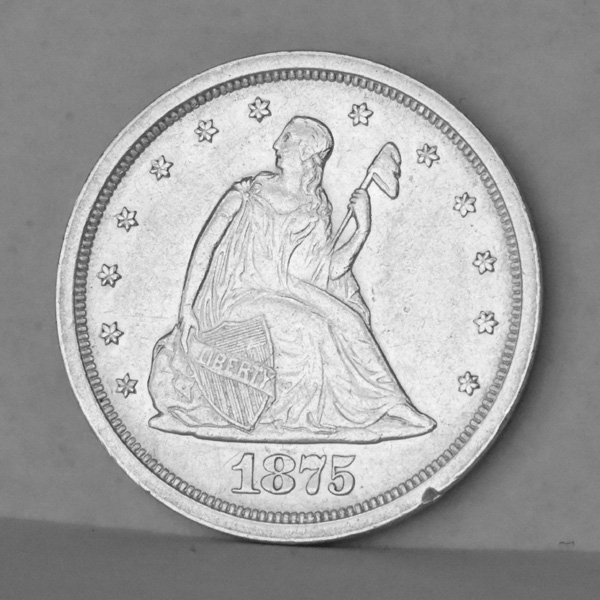Liberty Seated Twenty Cent Piece
1875 to 1878
 |
One of the most interesting coins ever minted by the United States is the twenty-cent piece. It was also the shortest-lived, being in production for only four years, from 1875 to 1878, and in fact, only proofs were minted in 1877 and 1878. Thus, the coin was circulated for only two years: 1875 and 1876. The coin was designed by William Barber and carried a seated liberty surrounded by stars on the obverse with a standing eagle on the reverse. The composition was 90% silver like other denominations of the period. Although produced in three locations during 1875, no coins were made in 1876 in San Francisco. And only 14,750 coins were made in Philadelphia that year, making this issue quite valuable. Also, only a few thousand of the coins were minted in Carson City during 1876 and this issue is extremely rare and very valuable, rising to $500,000 in uncirculated condition. Unfortunately, the coin was very similar to the quarter and consequently was quite unpopular with the public which undoubtedly led to its demise. I have been lucky enough to acquire an 1876 (P) coin in XF condition. |
 |
| My example above is likely an AU although I have not had it certified. I currently have 6 of these coins in my collection. One resides in the U. S. Types album and four are in an album labelled "2 cent piece, 3 cent piece, and 20 cent piece". The one below is in the D case. | This is the reverse of the coin, showing the 'S' mint mark for San Francisco. This coin is valued at $360 in AU grade and about 1,155,000 of them were minted. But only 14,750 of these 20 cent piece coins were minted in 1876 in Philadelphia and one of my six examples is of that date. That coin is valued at $475 but is only an XF grade. | |
 |
One of the most interesting facts about the twenty cent piece coins is that those minted in Carson City, Nevada, in 1875 and 1876 are all more valueable than those made in Philadelphia or San Francisco with the exception of the 1875 ones in very worn condition. The 1876 CC pieces are all worth more than $150,000 and while about 10,000 were made there that year, rivaling the total number of coins minted in Philadelphia, none are available to collectors who are not very wealthy. The only other examples that bring high prices are the 1877 and 1878 coins made in Philadelphia, of which only a few hundred were minted and all are proofs. Each is worth several thousand dollars. I suspect that all of the 10,000 twenty cent pieces made in Carson City in 1876 were never released to circulation or at the very least, were immediatly bought by someone and stored in what must have seemed to be a safe place. But according to modern records, only 20 are known to exist today. This means that all of the other 9,980 coins minted in Carson City in 1876 were either lost or destroyed at some point, likely many years ago. I cannot but help wonder if some record of this event also exists. |
 |
| This coin was also sold as an AU but has not been certified either. And it cost me only $295 and therefor is likely an XF 40 or XF 45 and is stored in the D case. | This is the reverse of the coin at left. |
1875: March 1: The United States Congress passes the Civil Rights Act, which prohibits racial discrimination in public accommodations and jury duty. March 3: President Grant authorizes issue of a twenty-cent piece. April 25: Ten sophomores from Rutgers College (modern-day Rutgers University) steal a one-ton cannon from the campus of the College of New Jersey (modern-day Princeton University) and start the Rutgers–Princeton Cannon War. May 17: Aristides wins the first Kentucky Derby. Tufts University and Harvard University play each other in arguably the first game of College Football: at Jarvis Field in Cambridge, Massachusetts. October 16: Brigham Young University is founded in Provo, Utah. October 25: The first performance of the Piano Concerto No. 1 by Pyotr Ilyich Tchaikovsky is given in Boston, Massachusetts with Hans von Bülow as soloist. November 9: In Washington, D.C., Indian Inspector E.C. Watkins issues a report stating that hundreds of Sioux and Cheyenne associated with Sitting Bull and Crazy Horse are hostile to the United States. The Battle of the Little Bighorn occurred the following year. December 4: Notorious New York City politician Boss Tweed escapes from prison and flees to Cuba, then to Spain. December 9: The Massachusetts Rifle Association, "America's oldest active gun club", is formed. |